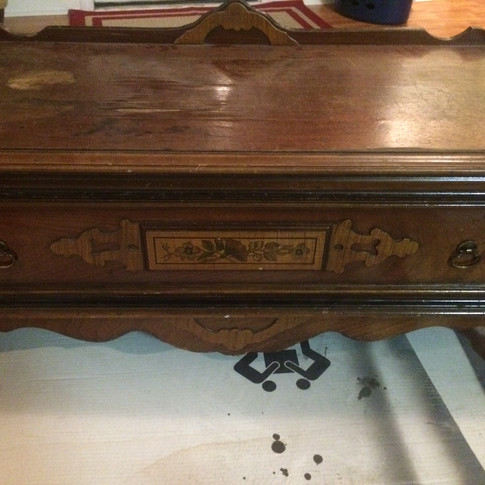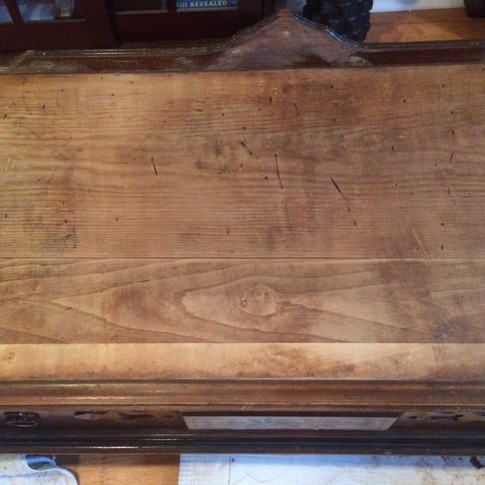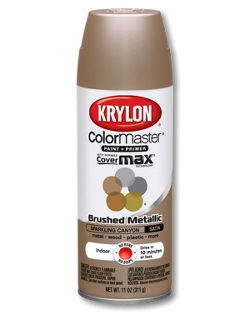THRIFT STORE REFINISH PROJECT #1
- Karen
- Aug 8, 2016
- 6 min read
This project started as a test run for some nice furniture that I want to refinish. I wanted to try different techniques on something that I'm not attached to. As an added bonus it provided the opportunity to gain product knowledge of new items we've recently added in our store.
I went to a local Habitat for Humanity ReStore to search for a suitable test item. I wanted something small, inexpensive but made of solid materials similar to the ones I'll be working with on my future project.
I came home with this small one-drawer chest which incorporated several elements I wanted to deal with: veneer which needed removing, solid wood that could be painted or stained, some detail work and hardware that needed updating.
The chest cost $25 and had a solid wood body with a veneer covered top which turned out to be solid wood underneath as well.
Here are some up-close pictures of the dated stain finish & graphics as well as the scratched & peeling veneer.
I, like probably most people, used to assume two things about veneer. First, it was hiding an inferior material. Second, once it started to peel the furniture was junk.
Upon further inspection, I discovered solid wood underneath the veneer. This meant the veneer could be removed, leaving the solid wood to be painted or stained, depending on the quality, condition and characteristics of the newly revealed surface.
Removing the veneer:
Veneer is applied using an adhesive which must be loosened in order to remove it. The thing that caused the veneer to crack & peel to begin with was moisture. To remove the veneer continue the process that already had started accidentally.
If you have a lot of time on your hands, you may simply keep the veneer wet by covering it with a damp towel and checking regularly to see how it's progressing. You'll need to make sure the towel stays damp, but not dripping.
If you're less patient and want to get straight to the fun stuff, you can speed up the process with the addition of heat. I achieved my goal of cleaning off the top of this chest quickly by using my iron in combination with the damp towel (Top Left). My iron does have an automatic shut-off for safety when left lying down, so I had to pay attention and lift it up and reset before it shut itself off.
Once I got in the groove though, I worked one section at a time, applying heat to the damp towel, breaking down the glue and peeling the veneer off with a putty knife as I worked (Top Right). Again, you must keep the towel damp as you work. But the process is fairly quick, especially if the veneer was already separated in places.
The bottom two photos above show the lovely wood below. It's certainly an inexpensive wood, compared to the finish the veneer was supposed to mimic, but solid. The one on the right shows the worm holes and other imperfections that made me decide to go with stain instead of paint. I could have filled the imperfections & hidden the whole thing with a coat of paint but decided to use the imperfections to my advantage, giving the top character and a more rustic, aged look.
Painting the body:

I started by lightly sanding the surface of the body of the chest as well as the face of the one drawer with a fine grit sanding sponge. The surface just needed to be deglossed enough for the new paint to adhere.
The next step was paint. I wanted to test out the new "chalk" finish paints that have become popular in furniture and cabinet restoration lately. Chalk finish is basically a super flat paint, made with the addition of a chalk or a chalky substance (gypsum, calcium carbonate) to obtain the look. One thing about chalky paint, it's costly. A quart of chalk paint ranges from $18 to over $30 depending on the brand (The original chalk paint was created & trademarked by Annie Sloan but there are many similar finish products now available) and where you're purchasing. (Craft stores tend to be more expensive than super stores or hardware stores.) To get the most bang for my buck, I primed the surface first. Priming isn't completely necessary. The chalk paint will adhere without it. However, primer is much less expensive and eliminated the need for additional coats of paint. I actually just used some flat white interior paint from a previous project. It did the job of covering and sealing the stained surface so that I only needed one coat of the new chalked finish paint.

We recently added Rust-Oleum's full line of Chalked Ultra Matte Paint, which comes in several premixed colors as well as tint bases. I chose Chiffon Cream for the base color of my chest. I used a good quality (but not the most expensive) brush, like the Do It Best Select 2" angle brush pictured, to apply the paint. Just don't use a throw away brush as the bristles tend to fall out & get stuck in your finish or cause you extra time removing them. A good brush also will clean up well and be reusable on other projects in the future and is worth a couple of extra dollars in the long run.
Top Coat:
After applying the base coat of chalked paint, I wanted to give the chest
an antiqued, distressed look. I used another of our new products, Krylon's spray-on version of dark finishing wax for chalky finishes. There are different ways to achieve the look, including old fashioned finishing wax, but since this was a new product for us, I wanted to try it out.
Working in small areas, I sprayed the finishing wax on and immediately wiped most of it off. One of the things I was looking for in my test furniture was some deep detail. The purpose for that was to show off how the wax accumulates in the grooves and enhances the aged look technique.


I used some old torn up t-shirts for wiping away the dark wax. Any cloth that is fairly lint-free will work.
Above are pictures of the drawer facing with the decal removed and both finishes applied. Note: The decal area is one place where I did use a small palm sander to completely remove the graphic & smooth the surface.
Finishing the Top:
Once the body I was complete, I went back to the top & finished the natural wood with Minwax Gel Stain in Brazilian Rosewood. I love this product because it's so easy to work with. I used the same type of old t-shirt rag to apply it to the top. The gel stain is thick, doesn't run or drip and just wipes on smoothly with a cloth. You can make the color richer & deeper by applying additional layers of stain.
After I was satisfied with the look of the gel stain, I finished the top with several thin coats of Minwax Wipe-on Poly. It's another Minwax product that is really easy to use. All I had to do was pour it on and spread it over the surface using the same type of t-shirt cloth as before. Working in layers, you can build a lustrous and hard finish without the harsh look of high gloss lacquer or polyurethane.
The Hardware:
The final touch was to do something about the old hardware. It was a dated antique brass finish. Although the original finish on the hardware was not really out of place on the new finish of the chest, I just wanted to give it a fresh look and something that stood out a little more against the background of the cream base/dark wax combo.
All I did was wipe the the two drawer pulls down with some acetone to clean off any oils that had built up, and then sprayed them with Krylon Color Master Paint + Primer in Oil Rubbed Bronze. The color looks almost black & mirrors the dark color of the wax build-up in the grooves of the chest.
Last of all I hit some of the high spots with a little more sanding, just for a emphasis on the distressed look. Below is the finished product. A much lighter & brighter chest, perfect for small storage in an extra bedroom or child's bedroom or playroom.

























































